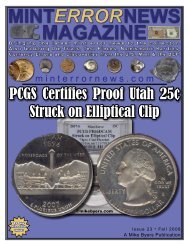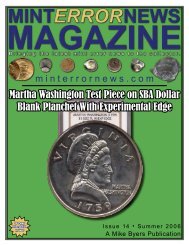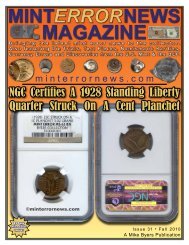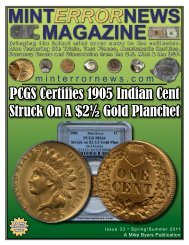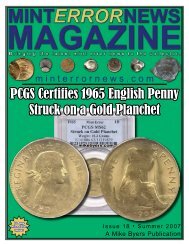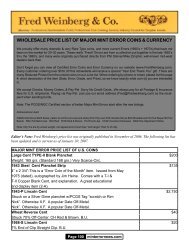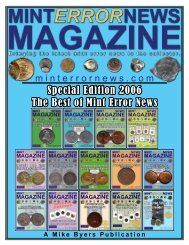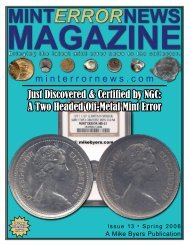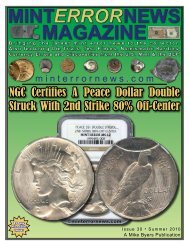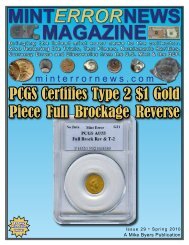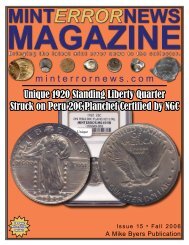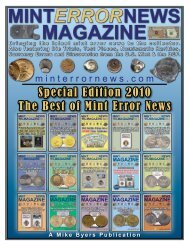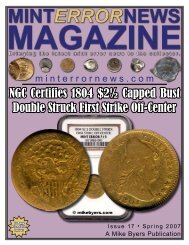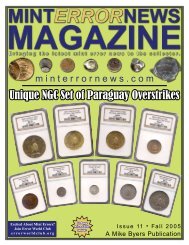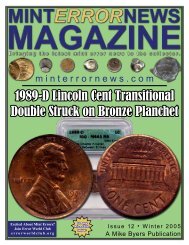Issue 1 - Mint Error News Magazine
Issue 1 - Mint Error News Magazine
Issue 1 - Mint Error News Magazine
Create successful ePaper yourself
Turn your PDF publications into a flip-book with our unique Google optimized e-Paper software.
ests at the bottom of the chamber.<br />
Amazingly, the features of a<br />
shrunken coin are fully preserved in<br />
spite of its explosive birth.<br />
Does the shrinking process work<br />
on all coins?<br />
The process works very well<br />
with most US and foreign coins and<br />
metal tokens.<br />
Although the process uses<br />
magnetic fields, the coin’s electrical<br />
conductivity determines how<br />
well it will shrink. Metals that are<br />
good electrical conductors, such as<br />
copper, silver, aluminum, or gold,<br />
work best. Poorer conducting copper-nickel<br />
alloys or plated steel<br />
coins may shrink only slightly.<br />
While older 90% silver coins such<br />
as Morgan Dollars work very well,<br />
coins with only 40% silver content<br />
may lose surface features due to<br />
their lower melting temperature.<br />
Coins with metals of lower melting<br />
temperature, such as copper plated<br />
zinc pennies, are simply destroyed<br />
in an explosion of molten zinc.<br />
Coins with higher features, such as<br />
proof coins, tend not to work as well<br />
as circulating coins. Coins or tokens<br />
with centered holes often result in<br />
the hole partially or entirely closing.<br />
The outer and inner parts of bimetal<br />
coins often shrink to a different degree,<br />
causing the center to loosen<br />
and sometimes be completely freed<br />
from the outer ring.<br />
How can shrunken coins be recognized?<br />
The most obvious characteristic<br />
is their smaller diameter.<br />
Shrunken coins have the same<br />
weight and density as a normal coin,<br />
but they are thicker. The copper center<br />
of US clad coins is a much better<br />
electrical conductor than the outer<br />
copper-nickel layers. This causes<br />
the center to shrink a bit more,<br />
becoming indented similar to the<br />
filling in an Oreo cookie. Because<br />
the coin’s features cause slight force<br />
imbalances, the coin’s rim may also<br />
become slightly scalloped. All three<br />
of these effects can be seen in the<br />
before and after scan of the edges of<br />
a quarter.<br />
Previously mirror-like surfaces<br />
acquire a frosted appearance<br />
due to microscopic dislocations<br />
in the surface of the metal. Also,<br />
faint lines, called Luders Lines,<br />
may radiate from the center of the<br />
coin, reflecting localized plastic<br />
deformation during the shrinking<br />
process. An interesting example is<br />
this Kennedy clad half dollar, where<br />
Kennedy’s bust appears “haloed” by<br />
Page 13 minterrornews.com<br />
radiating Luders Lines.<br />
Finally, certain features of<br />
a coin may actually shift relative<br />
to one another, particularly in clad<br />
coins. This effect can be seen in the<br />
close-up view of the shifted state<br />
motto in the Delaware state quarter<br />
pictured below.<br />
Other coins, such as this<br />
Sacagawea dollar, show a minimum<br />
of feature shifting and Luders lines.<br />
Need more information?<br />
Stoneridge Engineering is<br />
the exclusive source for “Electromagically”<br />
shrunken coins. Custom<br />
shrinking is also available. For<br />
more pictures and information visit<br />
www.teslamania.com.<br />
America’s Coin<br />
Supply Distributor<br />
Thousands of Products<br />
Always in Stock<br />
Wholesale Inquiries<br />
1-800-575-4007



